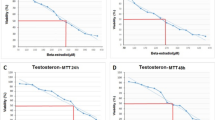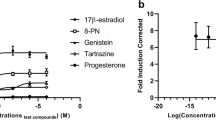Abstract.
The hepatoproliferative and cytochrome P450 enzyme inducing effects of two antiestrogens, tamoxifen and toremifene, were compared in female Sprague-Dawley rats using immunohistochemical staining methods. Equimolar doses of the antiestrogens (tamoxifen 45 mg/kg and toremifene 48 mg/kg) were given by oral administration to 6-week-old rats for 12 months including a 3-month recovery period. Controls received the vehicle carboxymethylcellulose. Altogether 90 rats were used in the study. Five rats per dose group were killed after 14 days, 5 weeks, 3, 6 and 12 months of treatment as well as after the 3-month recovery period. Hepatocellular carcinoma was found in four out of five rats after 12 months of tamoxifen treatment. After the 3-month recovery period all tamoxifen-treated rats had large liver tumors (diameter up to 3 cm). No tumors were observed in toremifene-treated rats. Liver cell proliferation was measured by the index of proliferating cell nuclear antigen (PCNA) expression. Immunohistochemical staining with the placental form of glutathione S-transferase (GST-P) was used as a marker for preneoplastic foci. Cytochrome P450 induction was measured using specific antibodies to isoenzymes. Tamoxifen increased the incidence of GST-P-positive foci significantly by 3 months of treatment but toremifene did not as compared with the controls. Liver cell proliferation increased significantly only in the liver tumors of tamoxifen-treated rats after 12 months of treatment and during the recovery period. Both antiestrogens induced the isoenzymes CYP2B1/2 and CYP3A1 within 14 days although tamoxifen was a more powerful inducer. Immunohistochemistry of rat liver sections showed a centrilobular localization of these induced enzyme proteins. The expression of CYP2B1/2 and 3A1 could also be observed in foci after 3 and 6 months of administration and in liver adenomas and in some carcinomas after 12 months of administration with tamoxifen. The results show that tamoxifen, but not toremifene, has the potential to induce and promote the development of rat hepatocarcinogenesis in this experimental model.
Similar content being viewed by others
Author information
Authors and Affiliations
Additional information
Electronic Publication
Rights and permissions
About this article
Cite this article
Kärki, A., Mäntylä, E., Hirsimäki, Y. et al. Comparison of the effects of tamoxifen and toremifene on rat hepatocarcinogenesis. Arch Toxicol 74, 249–256 (2000). https://doi.org/10.1007/s002040000116
Received:
Accepted:
Published:
Issue Date:
DOI: https://doi.org/10.1007/s002040000116




